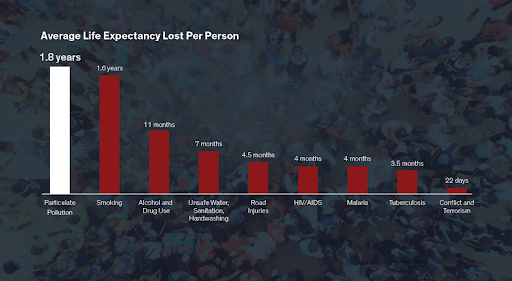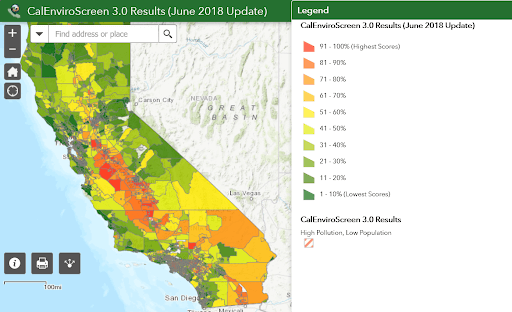This article is part of our Youth Voices series. At Ten Strands we believe that young people have valuable perspectives and a critical role in shaping our society and our world. We recognize their power to drive dialogue and create positive change, and are committed to providing a platform which amplifies their contributions.
During the pandemic, I moved two blocks from Montclair to Claremont. Those two blocks meant a change in cities, a change in counties, and a change in even the air we breathe. What immediately strikes you is that Montclair (in San Bernardino) has so few plants, it looks like a concrete wasteland; Claremont (in LA county) in comparison is practically a jungle. It’s sometimes even called the “City of Trees”. The reason why this is, and who it affects, is a complex issue that involves air pollution and systemic oppression. Montclair is a much poorer area than Claremont and it has much higher levels of air pollution. People who live in poorer areas often have limited opportunities that force them to live in areas with lower air quality, which causes increased health risks and a lower quality of life. This, in turn, makes it harder to get out of poverty and perfectly demonstrates how capitalism is inherently designed for the poor to stay poor.
The correlation between poverty and air pollution is pretty much 1:1. The California Office of Environmental Health Hazard Assessment (OEHHA) has a map on its website that combines the two statistics and shows where the correlation is strongest. There are also more maps where you can see both air pollution and poverty statistics separately to further depict this strong correlation. Communities with better air quality tend to be much richer and whiter than communities with lower air quality. But what does this mean, and how does it impact people’s livelihood?
Higher rates of air pollution are the cause of many health risks. According to the CDC, these risks include, “diminished lung function, increased hospital admissions and emergency department visits for asthma, and increases in premature deaths.” It’s incredibly dangerous for people who live in disadvantaged areas to have these increases in health problems because many people simply can’t pay for hospital bills and medications. If we go back to Claremont and Montclair as an example, according to the United States Census Bureau, the number of Montclair residents who are not covered by any type of health insurance is more than double the amount of residents in Claremont without health insurance. This link between increased health issues and poverty creates a dangerous cycle where people simply can’t escape being poor because they have to pay for more medical care than wealthier people do.
Poorer areas tend to have far fewer trees than wealthier areas, and this lack of tree canopy coverage can cause many issues. Trees can lower the air temperature in an area by quite a lot, which is very important to people’s health and happiness in the face of climate change. Trees also clean the air of CO2 and provide us with oxygen to breathe. The fact that there are so few trees in these areas that need them the most is appalling, and according to an ABC7 news piece written by Jovana Laura and Grace Manthey, it is also intentional.
“One of the things that have the clearest connection are these policies, these racist housing policies that the federal government enacted in the 1930s,” National Geographic environment reporter Alejandra Borunda said in the article. “They literally drew red lines around neighborhoods that were primarily inhabited by people of color and made it harder for those areas to get federally backed housing loans.”
These injustices are not new and they never were. Air quality has always been impacting lower income households and people of color the worst.

Air pollution creates a much lower quality of life for those affected by it. Pollutants in the air cause much higher risks of asthma and lung cancer, and they have even been found by the Air Quality Life Index (AQLI) to be one of the most dangerous threats to human health globally. This issue isn’t just some trivial piece of information – people are dying. And with the COVID-19 pandemic, these issues are made worse. COVID is an infection that targets your lungs, and people with asthma are at a much higher risk, so in turn, poorer communities are at a higher risk during the COVID-19 pandemic. The fact that many disadvantaged people cannot afford hospital bills amplifies this issue even more.
People of color are more likely to live in these areas that are burdened with high levels of air pollution than white people. Take Montclair and Claremont again as an example. In Montclair, the racial majority is Hispanic/Latino, which makes up 71.1% of the population. Compare this to Claremont, where the racial majority is white, at 63.9% of the city’s population. This isn’t just some random correlation between two cities, though. In Lois Yoksoulian’s article from The University of Illinois, she says “researchers found that for the 2014 U.S. total population average, fine particle air pollution exposures from the majority of source types are higher than average for people of color and lower than average for white people.”
The map from the California OEHHA has a setting that even lets you see how racial demographics correlate to poverty and air pollution. This is a serious issue; people of color face systemic discrimination on all levels and this is yet another layer. According to the CDC, “A study of selected states and cities with data on COVID-19 deaths by race and ethnicity showed that 34% of deaths were among non-Hispanic Black people, though this group accounts for only 12% of the total U.S. population.”
What is even causing all this air pollution, though? The answer is deeply rooted in capitalism and its flaws as a system. Just 90 corporate entities are responsible for two-thirds of all carbon emissions, going back to the industrial revolution. These corporations, many of which are worth billions of dollars, profit off of practices that contribute greatly to air pollution. Air pollution makes the rich get richer and the poor get poorer, which is an example of the many faults of capitalism. Many of these 90 companies have had some very poor track records in terms of environmentalism. For example, the multinational building materials corporation, Cemex, has been accused of violating air pollution laws on multiple occasions in Colorado and California, despite trying to maintain a public image that they’re environmentally friendly. These companies are putting trillions of tonnes of CO2 in the atmosphere, and it has a very real effect on many people’s lives.
I cannot think of any way that anyone could object to any of this that isn’t just an outright denial of facts. All the evidence strongly supports the links between poverty, racism, poor air quality, and capitalism, and it’s all on easy-to-find government websites. So why isn’t this issue more widely talked about? One possible reason is classism and the idea that people in poor communities are just inherently more prone to contaminating their areas so no wonder there’s more pollution where they’re living. People in poor communities don’t choose to live in places like that – they are forced to due to poverty since places with more air pollution tend to be cheaper. Many aspects of this topic are being talked about though, just nothing is being done about it. Climate action summits are held at the UN fairly frequently, but corporations are still able to get away with committing numerous violations to air pollution regulations, mostly unscathed. CO2 emissions still go up every year regardless of any regulations.

All of this data can be pretty disheartening, so what actions can you take about it? You can always try to limit your own carbon footprint by biking or walking instead of driving and just being mindful of what companies you support. These actions are generally good, and you should definitely do them if you can, but in the grand scheme of things they don’t do all that much. After all, people like you and I aren’t the ones responsible for the trillions of tonnes of CO2 in our atmosphere. Not to mention, many of these actions simply aren’t possible for disadvantaged people who aren’t privileged enough to have the money to control what companies they support or have the time to walk places instead of driving there. The absolute best action you can take is to talk about it. Spread the word about how air pollution is hurting people, particularly those most vulnerable to it, and how huge corporations get away with being responsible for ridiculous amounts of CO2 in our atmosphere. The more people are aware, the more people are going to demonstrate environmental literacy and change the world for the better.
Environmental literacy is more than just knowing that air pollution is a thing that exists, though. The only way to fully grasp the concept, and therefore improve the world, is to understand how air pollution relates to capitalism, racism, poverty, and injustice. Often, what ends up happening, though, is air pollution being taught as an inevitable thing that doesn’t connect to any social issues, or, even worse, as the fault of the very people whom it hurts the most. This is why spreading the word about these issues is so very important. Many people have been told a very one-sided version of this, and they simply don’t know the full story, so it’s our job to make sure people know how much these issues affect so many people around the world.
Poverty and air pollution in communities are linked and they create a feedback loop where the pollution decreases the price of the land in an area, which causes people in poorer communities to live there amid poor air quality that has negative effects on health and causes a lower quality of life. All of this is whilst multibillion-dollar corporations get rich off of creating said air pollution. We need to talk about this and spread the word about how air pollution has such a negative effect on people’s lives so that change can start happening.



2 Responses
A very relatable article that details the connections that people must understand to see why they are where they are in our society. Love it. Will use it. We want climate education that is carried out in History/Social Science and English, as well as STEM classes. laclimatereality.org/climatecurricula
As a Chaffey High School alumnus who grew up in Ontario with asthma and has dedicated my career to working to stop environmental pollution and the disproportionate impacts it has on low income and people of color, I am thrilled to see a current Chaffey student writing so passionately about this issue!